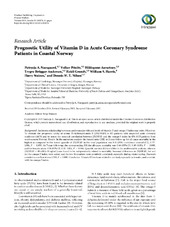Prognostic utility of vitamin D in acute coronary syndrome patients in coastal Norway
Næsgaard, Patrycja A.; Pønitz, Volker; Aarsetøy, Hildegunn; Andersen, Trygve Brugger; Grundt, Heidi; Harris, William S; Staines, Harry; Nilsen, Dennis W.T.
Peer reviewed, Journal article
Published version

Åpne
Permanent lenke
https://hdl.handle.net/1956/11293Utgivelsesdato
2015Metadata
Vis full innførselSamlinger
Originalversjon
https://doi.org/10.1155/2015/283178Sammendrag
BACKGROUND: An inverse relationship between cardiovascular risk and levels of vitamin D and omega-3 index may exist. OBJECTIVES: To evaluate the prognostic utility of serum 25-hydroxyvitamin D [25(OH)D] in 871 patients with suspected acute coronary syndrome (ACS) and to assess the seasonal correlation between 25(OH)D and the omega-3 index in 456 ACS patients from southwestern Norway. RESULTS: In the univariate analysis the hazard ratio (HR) at 2-year follow-up for all-cause mortality in the highest as compared to the lowest quartile of 25(OH)D in the total population was 0.61 (95% confidence interval (CI), 0.37-1.00), P = 0.050. At 7-year follow-up, the corresponding HR for all-cause mortality was 0.66 (95% CI, 0.49-0.90), P = 0.008, and for females alone 0.51 (95% CI, 0.32-0.83), P = 0.006. Quartile survival did not differ in the multivariable analysis, whereas 25(OH)D < 40 nM (<16 ng/mL) was found to be independently related to mortality. Seasonal differences in 25(OH)D, but not for the omega-3 index, were noted, and the two biomarkers were positively correlated, especially during winter-spring; Pearson's correlation coefficient was 0.358, P < 0.001. CONCLUSION: Vitamin D levels are related to survival, especially in females, and correlate with the omega-3 index.
